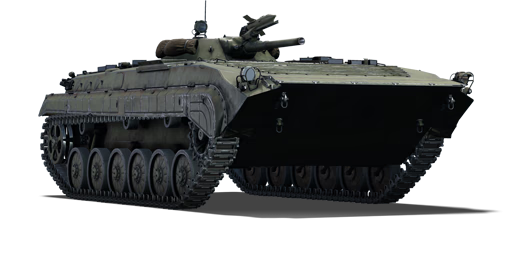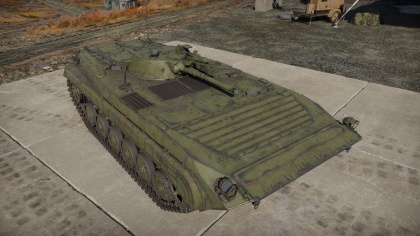ZBD86
Contents
Description
The ZhuangJia BuBing LÜDai 86 is a rank V Chinese light tank
with a battle rating of 7.7 (AB/RB/SB). It was introduced in Update 1.91 "Night Vision".
General info
Survivability and armour
Describe armour protection. Note the most well protected and key weak areas. Appreciate the layout of modules as well as the number and location of crew members. Is the level of armour protection sufficient, is the placement of modules helpful for survival in combat? If necessary use a visual template to indicate the most secure and weak zones of the armour.
Mobility
| Game Mode | Max Speed (km/h) | Weight (tons) | Engine power (horsepower) | Power-to-weight ratio (hp/ton) | |||
|---|---|---|---|---|---|---|---|
| Forward | Reverse | Stock | Upgraded | Stock | Upgraded | ||
| Arcade | 73 | 13 | 13 | 465 | 572 | 35.77 | 44 |
| Realistic | 66 | 12 | 265 | 300 | 20.38 | 23.08 | |
Armaments
Main armament
Give the reader information about the characteristics of the main gun. Assess its effectiveness in a battle based on the reloading speed, ballistics and the power of shells. Do not forget about the flexibility of the fire, that is how quickly the cannon can be aimed at the target, open fire on it and aim at another enemy. Add a link to the main article on the gun: {{main|Name of the weapon}}. Describe in general terms the ammunition available for the main gun. Advise about how to use them and how to fill the ammunition storage.
Additional armament
Some tanks are armed with several guns in one or more turrets. Evaluate the additional weaponry and give advice on its use. Describe the ammunition available for additional weaponry. Give advice on about how to use them and how to fill the ammunition storage. If there is no additional weaponry remove this subsection.
Machine guns
Offensive and anti-aircraft machine guns not only allow you to fight some aircraft but also are effective against lightly armoured vehicles. Evaluate machine guns and give recommendations on its use.
Usage in battles
Describe the tactics of playing in the vehicle, the features of using vehicles in the team and advice on tactics. Refrain from creating a "guide" - do not impose a single point of view but instead give the reader food for thought. Describe the most dangerous enemies and give recommendations on fighting them. If necessary, note the specifics of the game in different modes (AB, RB, SB).
Pros and cons
Summarise and briefly evaluate the vehicle in terms of its characteristics and combat effectiveness. Mark its pros and cons in a bulleted list. Try not to use more than 6 points for each of the characteristics. Avoid using categorical definitions such as "bad", "good" and the like - use substitutions with softer forms such as "inadequate" and "effective".
Pros:
Cons:
History
Development
In the 1950’s, Soviet armored personnel carrier (APC) tactics consisted of lightly armored vehicles that would transport soldiers to combat zones, and then head back behind the lines to safety. During this time, the West German Bundeswehr was using the Schützenpanzer Lang and infantry fighting vehicle (IFV) tactics, where the vehicles would work with the infantry and tanks in order to support them, especially against lightly armored targets. The BMP was a Soviet IFV design created in the late 1950’s. Some of the requirements were the ability for all of the infantry carried to be able to fire from within the vehicle, which was unseen before in IFV designs. It was intended to support the infantry and combat enemy light vehicles. The design placed emphasis on speed and maneuverability, potent armament, and sufficient armament to protect against 23 mm autocannons over the frontal arc. There was a debate over how the vehicle should be wheeled or tracked, and a number of options were explored including hybrid designs with both. The design that was chosen was a tracked vehicle with the engine in the front and the crew compartment in the rear; it was designated the Object 764. A prototype was created in 1964, and the final design was chosen in 1965 - an improved model called the Object 765. In service the production model was called the BMP-1.
Design
The BMP-1 features a fully tracked hull, with a sharply angled glacis at the front, a centrally mounted turret, and a crew compartment in the rear of the hull, with doors for the infantry to mount and dismount the vehicle. The hull layout is as follows: the engine was in the front right section of the hull. The driver sat to the front left of the vehicle, the commander sat right behind the driver, and the gunner sat in the right side of the turret. The troop compartment located at the rear of the vehicle could seat 8 infantry soldiers. The ability to fire from inside the vehicle was provided by four firing ports on each side of the hull and one in the left door. There are also four hatches in the roof. The infantry sit on two benches with padding, back to back, facing the outer sides of the vehicle. The armor of the frontal arc is enough to generally protect against 20 mm autocannon fire, the side armor generally protects against 12.7 mm machine gun fire, and the roof and rear armor protects against small arms fire and shell fragments. In addition, the sloped glacis on the front of the hull also increased the chances of shells bouncing, because of the extreme angles. The protection level depended somewhat on the version of the BMP-1 in question, as different nations had differing levels of armor quality. The main armament consisted of a 73 mm 2A28 Grom smoothbore semi-automatic cannon, along with a 9M14 Malyutka anti-tank guided missile (ATGM). Secondary armament consisted of a 7.62 mm PKT machine gun. The engine provides 300 hp, and is a six-cylinder four-stroke diesel engine. The suspension system used was a torsion bar suspension system. The BMP-1 is fully amphibious with little preparation. Before entering the water a trim vane has to be raised, which provides additional frontal armor when in the lowered position. It can achieve 65 kph (40 mph) on road and 8 kph (5 mph) in water.
Production and Service
Over 20,000 BMP-1's were produced in the Soviet Union alone, with many more produced in China and Czechoslovakia. The BMP-1 was widely exported and saw significant combat worldwide. BMP-1's participated in the Yom Kippur War, the Angolan Civil War, the Iran-Iraq War, the Gulf War, and many other conflicts. It was well liked for its maneuverability, but it was found that the cannon lacked effective range and the 9M14 ATGM's were hard to control. During the Gulf War it was found that the 25 mm Bushmaster cannon found on the M2/M3 Bradley could consistently penetrate the frontal armor of the BMP-1, even at range.
BMP-1P Upgrade
The BMP-1P was an upgrade to the ATGM systems of the BMP-1. It replaced the 9M14 Malyutka missiles with 9M113 Konkurs or 9M111 missile. This increased the weight of the vehicle, leading to a slight decrease in maneuverability.
Chinese Service
China produced their own version of the BMP-1 called the ZBD 86, also known as Type 86. They produced a total of over 3,000 Type 86 vehicles of different variants. Over 1,000 are still in service today.
Media
Excellent additions to the article would be video guides, screenshots from the game, and photos.
See also
Links to the articles on the War Thunder Wiki that you think will be useful for the reader, for example:
- reference to the series of the vehicles;
- links to approximate analogues of other nations and research trees.
External links
Paste links to sources and external resources, such as:
- topic on the official game forum;
- encyclopedia page on the tank;
- other literature.
| China light tanks | |
|---|---|
| Type 63 | Object 211 · Type 63 · ZTS63 |
| Type 62 | Type 62 |
| WZ551 | PTL02 · WMA301 |
| ZBL08 | ZLT11 |
| Type 86 | ZBD86 |
| WZ502 | ZBD04A |
| ROC | M41D · M64 |
| Type 59 | QN506 |
| USA | ␗M8 LAC · ␗M3A3 Stuart · ␗M3A3 (1st PTG) · ␗M5A1 · ␗M24 · ␗M18 GMC · ␗M41A3 |
| USSR | ␗T-26 · T-26 No.531 · ␗PT-76 |





